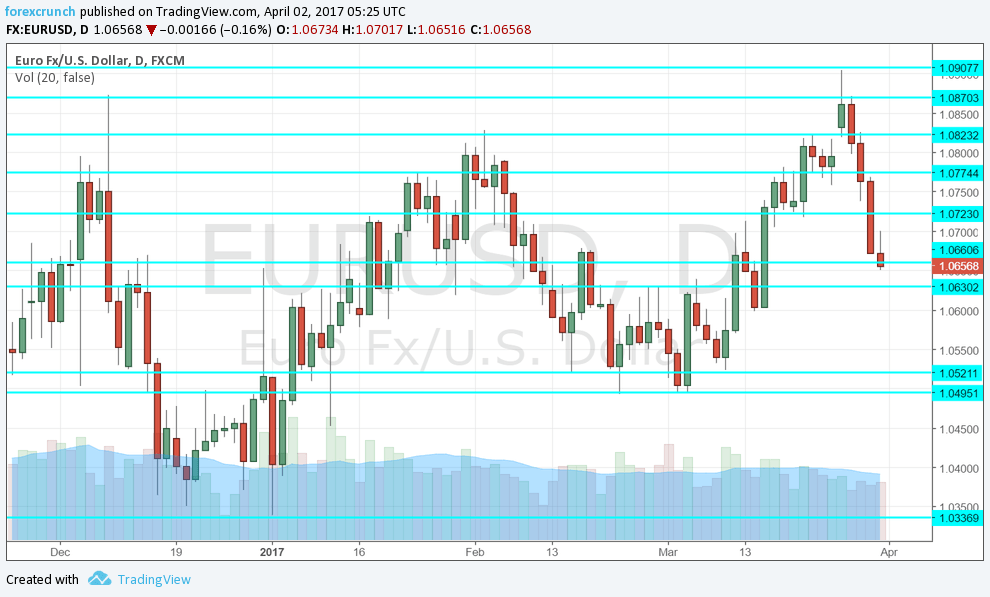EUR/USD reached new highs at the close of the first quarter. Are more gains on the cards? The ECB meeting minutes stand out in a busy start to Q2. Here is an outlook for the highlights of this week and an updated technical analysis for EUR/USD.
Optimism is widening in Europe, with the German IFO Business Climate reaching new highs. The victory for Merkel’s party in Saarland also assisted the common currency. Things turned around with the ECB’s undoing of its hawkish tilt that was followed by a drop in inflation. These both hit the euro. In the US, Trump’s health care failure, as well as some Fed dovishness, continued weighing on the greenback, but the leap in consumer confidence ignited a big dollar comeback.
[do action=”autoupdate” tag=”EURUSDUpdate”/]EUR/USD daily chart with support and resistance lines on it. Click to enlarge:
- Manufacturing PMIs: Monday morning: Spain at 7:15, Italy at 7:45, final French figure at 7:50, final German number at 7:50 and final euro-zone print at 8:00. Back in February, Markit showed that Spain had a score of 54.8 points in the manufacturing sector, above the 50 point threshold separating expansion and contraction. A score of 54.6 is on the cards now. Italy, the third-largest economy, had 55 points. A tick up to 55.2 is predicted now. According to the initial read for March, France had a score of 53.4 points. Germany’s PMI surged to 58.3, steaming forward. The preliminary read for the whole euro-zone stood at 56.2 points. The last three figures will probably be confirmed.
- PPI: Monday, 9:00. Producer prices eventually feed into consumer prices and are watched by the European Central Bank. Prices advanced 0.7% last time. A rise of 0.2% is on the cards.
- Unemployment rate: Monday, 9:00. The level of unemployment has been gradually falling but still remains high. In the past two months, unemployment was at 9.6%. Unemployment surpassed 12% in 2013. A slide to 9.5% is projected now.
- Spanish Unemployment Change: Tuesday, 7:00. Spain is the euro area’s fourth-largest economy and suffers one of the highest levels of unemployment. This monthly snapshot provides a timely update on the situation. Back in February, the number of the unemployed dropped by 9.4K. A drop of 41.2K is predicted.
- Retail Sales: Tuesday, 9:00. The aggregate number for the euro-zone is published after the main countries have already released their own numbers. Nevertheless, it is still watched. A drop of 0.1% was recorded last time. An increase of 0.5% is forecast.
- Services PMIs: Wednesday morning, Spain at 7:15, Italy at 7:45, final French figure at 7:50, final German number at 7:50 and final euro-zone print at 8:00. Back in February, Markit showed stronger growth in Spain’s services sector, with a score of 57.7 points. 57.2 is expected now. Italy lagged behind with 54.1 points. 54.3 is predicted now. According to the initial March read for France, the score stood at a surprisingly high level of 58.5 points. Germany had a score of 55.6 points. The euro-zone had 56.5. The preliminary scores will likely be confirmed now.
- German Factory Orders: Thursday, 6:00. Despite being a volatile number, it has some impact. Back in January, the volume of orders fell by 7.4%. A bounce is likely now: 3.5%.
- Retail PMI: Thursday, 8:10. Markit’s retail PMI slipped just under the 50-point threshold to 49.9. All in all, things are balanced.
- ECB Meeting Minutes: Thursday, 11:30. The European Central Bank left its policy unchanged in March but it did contain one hawkish tilt: the Frankfurt-based institute removed the phrase about using “all instruments” as the sense of urgency is gone. Will we see this cautious optimism in the minutes? This is an open question as markets are looking for guidance about the interest rate hike – if it can happen before QE ends.
- German industrial output: Friday, 6:00. Contrary to factory orders, Germany’s industrial output jumped back in January, by 2.8%. A slide worth 0.1% is projected now.
- German Trade Balance: Friday, 6:00. Germany’s export machine helps maintain a solid surplus for the euro-zone as a whole. The German surplus slipped below 20 billion euros last time to 18.5 billion. A rise to 19.4 billion euros is on the cards.
- French Industrial Production: Friday, 6:45. The second-largest economy suffered a small drop of 0.3% back in January. An increase of 0.5% is forecast/
- French Trade Balance: Friday, 6:45. Contrary to Germany, France has a chronic trade deficit. This deficit widened to 7.9 billion euros in January. A deficit of 4.9 billion euros is on the cards.
* All times are GMT
EUR/USD Technical Analysis
Euro/dollar was on the up and up, challenging the 1.0870 level (mentioned last week).
Technical lines from top to bottom:
The round number of 1.10 is the high line for now. The new 2017 high of 1.0905 is the next line.
The swing high of 1.0870 is the swing high in December and remains fierce resistance. 1.0830 was the 2017 high and follows closely.
1.0775 capped the pair in January and remains of importance. 1.0720 was also a high in January.
The pair was unable to crack 1.0660 in February and it remains the high end of the range. 1.0630 is the next level, holding back the pair in February and March.
1.0520 is a relic of the past but still serves as a cap. The more recent low of 1.0490 follows very closely.
Further below, we find the multi-year low of 1.0340. Only 1.0150 separates the pair from parity at this point.
I remain bullish on EUR/USD
While not everything is going in the pair’s favor at the moment with the monetary side weighing (lower inflation and ECB’s skepticism), optimism about euro-zone growth and political prospects is met with skepticism about tax cuts in the US and a cautious Federal Reserve.
Our latest podcast is titled Brexit Bad and “Clean Coal”
Follow us on Sticher or iTunes
Safe trading!

